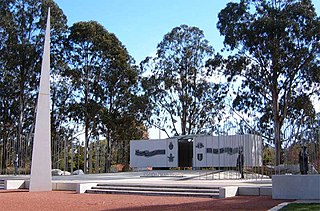Design
The two key elements of the design are:
- a bronze commemorative wall with 'touchstone plaques' carrying the name and rank, date of death (day, month and year), and place of death, of police officers who have died whilst on active duty;
- a large stone paved area or 'terrain' across which visitors move to gain access to the wall.
The surface of the touchstone wall is clad in cast bronze panels with a slight textural feel and a dark patina. The surface of the cladding is smooth enough to allow the patina to have a gloss wax finish. The touchstones are also cast bronze but have a golden, almost polished patina, that will change over time with the degree to which each stone is touched. There are 1200 touchstones, which is meant to symbolise the ongoing danger for police on duty.
The 'terrain' tilts to direct visitors to the wall, with undulations that is intended to create "an uncertainty in experience and reflects the uncertain path that police tread in the performance of their duty."
The design also incorporates elements acknowledging Saint Michael, the patron saint of policing.
Access roads have been constructed from King's Avenue, joining to the previous the lakeside road.
Design competition
A competition for the design was sponsored by the Australasian Police Ministers' Council (APMC), launched on 2 March 2005 by Senator Christopher Ellison, the Federal Minister for Justice and Customs. 77 entries were submitted by its close on 29 April 2005.
The memorial cost A$2.4 million.
The winning entry was by Fairweather Proberts Architects (Brisbane).
National Police Memorial Project Dedication Team
The Australian Federal Police Recognition and Ceremonial Team were given the honour in managing the Dedication Project.
Dedication of the NPM
The Memorial was officially dedicated by Hon. John Howard, Prime Minister of Australia, on 29 September 2006, National Police Remembrance Day.
The Master of Ceremonies was Ita Buttrose.
More than 700 police from all states and the Australian Federal Police were gathered for the official opening, the first time since the opening of Old Parliament House in 1927 that there had been such a mass gathering of Australian police in Canberra.
Death of Constable Joseph Luker
The first policeman to die on duty was Constable Joseph Luker, aged 38, who died on 26 August 1803, after being bludgeoned to death when Sydney was only 15 years old.
Death of Sergeant Colin McKenzie
NSW Police Force members have suffered the largest losses of all Australian Police Forces, and to that end the last Australian Police Officer to die on duty before the official dedication was New South Wales Police Force Sergeant Colin McKenzie, aged 50, who died on 28 September 2006, the eve of the official opening, after falling ill at the Dedication rehearsal session at the National Police Memorial in Canberra. This 30-year veteran New South Wales Police Force policeman complained to colleagues of feeling ill, then collapsed and died. In memory of the Sergeant, Sergeant McKenzie's cap was carried by a NSW Police Force Sergeant on a cushion, leading the NSW Police Force Contingent in the march from Old Parliament House to the NPM in Kings Park, Canberra in a moving tribute.

The Australian Capital Territory, known as the Federal Capital Territory (FCT) until 1938, is a landlocked federal territory of Australia containing the national capital Canberra and some surrounding townships. It is located in southeastern Australian mainland as an enclave completely within the state of New South Wales. Founded after Federation as the seat of government for the new nation, all important institutions of the Australian Government are headquartered in the territory.

The Australian Federal Police (AFP) is the national and principal federal law enforcement agency of the Australian Government with the unique role of investigating crime and protecting the national security of the Commonwealth of Australia. The AFP is an independent agency of the Department of Home Affairs and is responsible to the minister for home affairs and accountable to the Parliament of Australia. As of October 2019 the commissioner of the Australian Federal Police is Reece Kershaw, formerly the Northern Territory Police Commissioner.

Patina is a thin layer that variously forms on the surface of copper, brass, bronze and similar metals, or certain stones, and wooden furniture, or any similar acquired change of a surface through age and exposure.

The New South Wales Police Force is the primary law enforcement agency of the state of New South Wales, Australia. Divided into Police Area Commands (PACs), for metropolitan areas and Police Districts (PDs), for regional and country areas, the NSW Police Force consists of more than 400 Police stations and over 18,000 officers, who are responsible for covering an area of 801,600 square kilometres and a population of more than 8.2 million people.

The Waterloo Creek massacre refers to a series of violent clashes between mounted police, civilian vigilantes and Indigenous Gamilaraay peoples, which occurred southwest of Moree, New South Wales, Australia, during December 1837 and January 1838. The Waterloo Creek Massacre site is listed on the New South Wales Heritage Register as a place of significance in frontier violence leading to the murder of Gamilaraay people. The events have been subject to much dispute, due to wildly conflicting accounts by various participants and in subsequent reports and historical analyses, about the nature and number of fatalities and the lawfulness of the actions. Interpretation of the events at Waterloo Creek was raised again during the controversial "history wars" which began in the 1990s in Australia.

The Anzac Memorial is a heritage-listed war memorial, museum and monument located in Hyde Park South near Liverpool Street in the CBD of Sydney, Australia. It is also known as Anzac War Memorial, War Memorial Hyde Park and Hyde Park Memorial. The Art Deco monument was designed by C. Bruce Dellit, with the exterior adorned with monumental figural reliefs and sculptures by Rayner Hoff, and built from 1932 to 1934 by Kell & Rigby. This state-owned property was added to the New South Wales State Heritage Register on 23 April 2010.

Victoria Police is the primary law enforcement agency of Victoria, Australia. It was formed in 1853 and currently operates under the Victoria Police Act 2013.
The Australian–American Memorial is in Canberra, the national capital of Australia, and commemorates the help given by the United States during the Pacific War.

The Royal Australian Air Force Memorial is on Anzac Parade, the principal ceremonial and memorial avenue of Canberra, the capital city of Australia.

The Australian National Korean War Memorial is on Anzac Parade, the principal ceremonial and memorial avenue in Canberra, the national capital city of Australia.

ACT Policing is the portfolio of the Australian Federal Police (AFP) responsible for providing policing services to the Australian Capital Territory (ACT). The Australian Capital Territory Police was an independent police force responsible for policing the ACT until 19 October 1979, when it was merged with the Commonwealth Police to form the AFP.
The Australian Protective Service (APS) was an Australian Commonwealth law enforcement agency which existed between 1984 and 2004. The APS was created by the separation of the Protective Service component of the Australian Federal Police (AFP) into a new agency based upon recommendations contained in the Stewart Royal Commission of Inquiry into Drug Trafficking. It was initially responsible for protecting personnel and property of the Australian government; foreign diplomatic missions and Internationally Protected Persons (IPPs); and the provision of custodial services at immigration detention centres. From 1990 the APS commenced providing Counter Terrorist First Response duties at certain security-designated airports including the specialist Bomb Appraisal Officer function and, following the terrorist attacks of 11 September 2001, deployed Air Security Officers on board Australian registered commercial aircraft. Close Personal Protection (CPP), or bodyguard, functions were never provided by the APS; where this has been a Commonwealth responsibility, the function was provided by the AFP.

The National Law Enforcement Officers Memorial in Washington, D.C., United States, at Judiciary Square, honors 21,183 U.S. law enforcement officers who have died in the line of duty throughout American history. The National Law Enforcement Officers Memorial Fund (NLEOMF) was established by former US Representative Mario Biaggi (D-NY), a 23-year New York City police veteran.
Kenneth Edward Moroney, is a former police officer who served as the Commissioner of the New South Wales Police Force from 2002 until 2007.
The Nursing Service Cross (NSC) is a conspicuous service decoration of the Australian honours and awards system, instituted by Letters Patent on 18 October 1989.

The New South Wales Police Force Academy, the sole provider of police training and education to probationary constables of the New South Wales Police Force, is located at the city of Goulburn in the Southern Tablelands of New South Wales, Australia.

The King George V Memorial has been located outside Old Parliament House, Canberra since the 1940s. Commissioned in 1936 and largely completed by 1941, it took until 1953 to officially unveil the monument due to delays to the final elements of its construction which resulted from the Second World War. The Memorial was originally located directly in front of the-then Parliament House, but was moved to its current location in 1968.

The Australian Peacekeeping Memorial, located at the southern end of Anzac Parade in Canberra, Australian Capital Territory, commemorates the service and sacrifice of all Australians who have served on peacekeeping or peacemaking missions around the world. It was inaugurated on 14 September 2017 by the Governor-General of Australia, General Sir Peter Cosgrove AK MC. The Memorial is a living memorial that commemorates the service of all Australian peacekeepers- past, present and into the future.
The Special Honours Lists for Australia are announced by the Sovereign and Governor-General at any time. In 2003, a list of people received recognition for their parts in the response to the 2002 Bali Bombings.

















